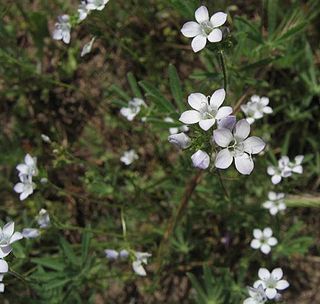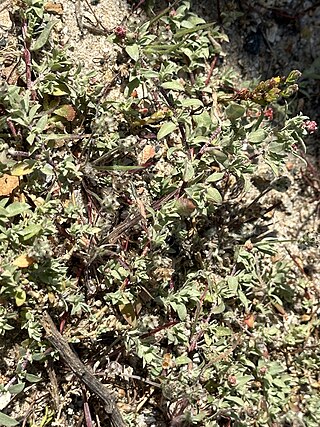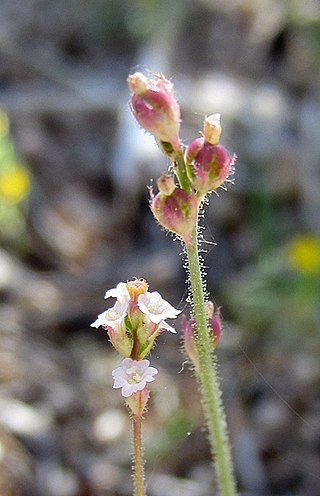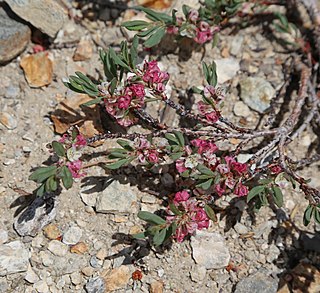
Rhus integrifolia, also known as lemonade sumac, lemonade berry, or lemonadeberry, is a shrub to small tree. It is native to the Transverse and Peninsular Ranges and the South Coast regions of Southern California. This extends from Santa Barbara County and the Channel Islands to San Diego County and extending into north-central Pacific coastal Baja California and its offshore islands such as Cedros Island.

Cerastium glomeratum is a species of flowering plant in the family Caryophyllaceae known by the common names sticky mouse-ear chickweed and clammy chickweed. It is native to Europe, Macaronesia to Assam but is known on most continents as an introduced species. It grows in many types of habitat. The blooming period is February, March, April, and May.

Erigeron coulteri is a species of flowering plant in the family Asteraceae known by the common names large mountain fleabane, Coulter's fleabane, and Coulter's daisy.

Gilia angelensis is a species of flowering plant in the phlox family known by the common name chaparral gilia. It is native to the coastal hills and mountains of California and Baja California, where it is a member of the chaparral ecosystem., especially in the Transverse Ranges.

Abronia turbinata is a species of flowering plant in the four o'clock family known by the common name transmontane sand-verbena. It is native to eastern California and Oregon and western Nevada, where it grows in desert and plateau scrub.

Eucrypta chrysanthemifolia is a species of flowering plant in the waterleaf family known by the common name spotted hideseed.

Acourtia microcephala is a species of flowering plant in the family Asteraceae known by the common name sacapellote. It is native to southern California and Baja California, where it grows in woodland and chaparral, especially in the coastal mountain ranges.

Atriplex coulteri is a species of saltbush known by the common names Coulter's saltbush and Coulter's orache.

Boerhavia coccinea is a species of flowering plant in the four o'clock family which is known by many common names, including scarlet spiderling, red boerhavia, and in Spanish, hierba del cancer and hierba de la hormiga.

Boerhavia wrightii is a species of flowering plant in the four o'clock family known by the common name largebract spiderling. It is native to the deserts of the southwestern United States and northern Mexico, where it grows amongst desert shrubs. This is an annual herb producing a slender, spidery erect stem to about 70 centimeters in maximum length. The leaves are lance-shaped to oblong with rippled edges and roughly pointed ends. Most of the leaves grow near the base of the plant. The inflorescences appear at the ends of the slim stem branches. They bear a few pale pink flowers, each just a few millimeters long, with adjacent reddish or pinkish bracts.
Cirsium ciliolatum is a species of thistle known by the common name Ashland thistle. It is endemic to the Klamath Mountains, where it is known from only a few occurrences in Jackson and Josephine Counties in Oregon, as well as neighboring Humboldt and Siskiyou Counties in California. It is related to Cirsium undulatum and may be more accurately described as a variety of that species.

Phacelia ivesiana is a species of flowering plant in the borage family, Boraginaceae. Its common names include Ives' phacelia and Ives' scorpionweed. It is divided into varieties that have been called sticky scorpionweed. It is native to the western United States.

Polygonum shastense is a species of flowering plant in the knotweed family known by the common name Shasta knotweed. It is native to sections of southwestern Oregon, northwestern Nevada, and northern and central California, where it grows in rocky and gravelly mountainous habitat up to 3300 meters (11,000 feet) elevation. It is most common in the Sierra Nevada. The species name refers to its occurrence on Mount Shasta in Shasta County, California.

Pyrrocoma carthamoides is a species of flowering plant in the family Asteraceae known by the common name largeflower goldenweed. It is native to western North America from British Columbia to northeastern California to Wyoming, where it is known from grassland, woodlands, forests, barren areas, and other habitat. It is a perennial herb growing from a taproot and producing one or more stems to about half a meter in maximum length, the stems reddish-green and leafy. The largest leaves are at the base of the stem, measuring up to 20 centimeters long, lance-shaped with spiny sawtoothed edges. Leaves higher on the stem are smaller and hairier. The inflorescence is a single flower head or a cluster of up to four. Each bell-shaped head is lined with phyllaries each up to 2 centimeters long. It has many yellow disc florets surrounded by a fringe of yellow ray florets up to 7 millimeters long; ray florets are occasionally absent. The fruit is an achene which may be well over a centimeter in length including its pappus.
Packera bernardina is a rare species of flowering plant in the aster family known by the common name San Bernardino ragwort.

Solidago multiradiata is a species of goldenrod known by the common names Rocky Mountain goldenrod, northern goldenrod, and alpine goldenrod. It is native to North America, where it can be found throughout the northern regions, including Alaska and most of Canada (all 3 territories plus all provinces except Prince Edward Island, including territory north of the Arctic Circle. Its distribution extends through the western United States as far south as Arizona, New Mexico, and California. It is known mostly from the subalpine and alpine climates of high mountain ranges. Its habitat includes tundra and mountain meadows.

Sphaeralcea coulteri is a species of flowering plant in the mallow family known by the common name Coulter's globemallow. It is native to the Sonoran Desert, its distribution extending from northern Mexico north into California and Arizona. It is an annual herb, its slender, hairy stems sprawling or growing erect to a maximum height near 1.5 meters. The thin, gray-green leaf blades are wide and short, heart-shaped or triangular in shape, and measure up to about 5 centimeters long. They have a few wide lobes along the edges which may have teeth or smaller lobes. The leafy inflorescence bears clusters of flowers each with five wedge-shaped orange petals around a centimeter long, and yellow anthers.
Stephanomeria elata is a species of flowering plant in the family Asteraceae known by the common names Santa Barbara wirelettuce and Nuttall's wirelettuce. It is native to Oregon and California, where it grows in coastal and inland mountain ranges, including the Sierra Nevada. It can be found in many types of habitat. It is an annual herb producing a slender, erect stem often exceeding one meter in maximum height. It is hairy to hairless and often glandular. The leaves are mostly located in a basal rosette, the largest reaching 10 centimeters long. Smaller, much-reduced leaves occur farther up the stem. The leaves drop early, leaving the plant naked for most of the year. Flowers occur singly or in small clusters along the stiff branches. Each head contains up to 15 or 16 ray florets, each with an elongated tube and a pink ligule 6 or 7 millimeters long. The fruit is an achene tipped with a spreading cluster of long, plumelike pappus bristles.

Vaccinium myrsinites is a species of flowering plant in the heath family known by the common name shiny blueberry. It is native to the southeastern United States from Alabama, Georgia, South Carolina and Florida. It may occur as far west as Louisiana.
Drosera peruensis is a carnivorous plant of the genus Drosera, commonly known as the Peruvian sundew. This Drosera species was first identified in Peru in 2002 by Tânia Regina dos Santos Silva and Mireya D. Correa following work to update the genus Drosera for the reference text, Flora Neotropica..
















